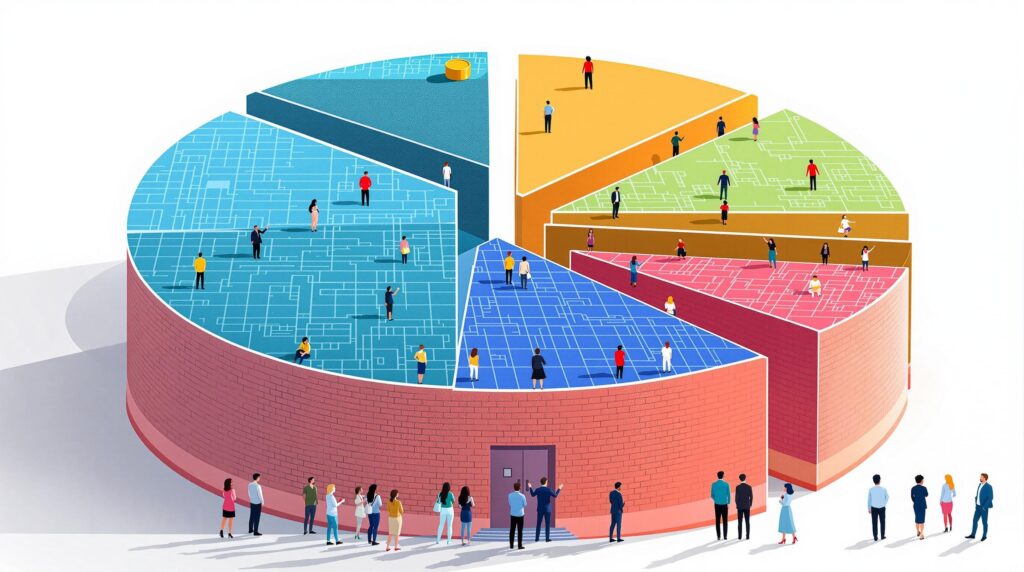[rev_slider alias=”slider-1″][/rev_slider]
The Foundation of Layer 1 Blockchains
In the world of blockchain technology, Layer 1 blockchains are the backbone that upholds cryptocurrency networks. But what exactly makes them so foundational? Simply put, Layer 1 blockchains are the core frameworks that ensure decentralization, security, and scalability in a decentralized digital environment. Their key role is to establish a robust infrastructure for executing transactions and maintaining the blockchain’s integrity.
What is a Layer 1 blockchain? A Layer 1 blockchain is the base layer of a blockchain network, responsible for processing transactions directly on its own main network without relying on another blockchain.
Let’s delve deeper into the critical components that make Layer 1 blockchains indispensable:
- Decentralization: One of the main attractions of blockchain technology is its decentralized nature, eliminating the need for a central authority. Layer 1 blockchains use a distributed network of nodes to validate transactions, thereby ensuring that no single entity can control the entire system. This is essential for maintaining trust and transparency within the network.
- Security: Layer 1 blockchains employ various security protocols to protect the data from tampering or hacking. Through complex cryptographic techniques, these blockchains create an immutable ledger that securely records every transaction and resists malicious attacks.
- Scalability: Despite their many advantages, one of the ongoing challenges for Layer 1 blockchains is scalability. It refers to the blockchain’s ability to handle an increasing number of transactions without compromising speed or performance. Various consensus mechanisms, like Proof of Work (PoW) and Proof of Stake (PoS), are employed to address these concerns and improve throughput.
Think of Layer 1 blockchains as the 21st-century equivalent of a city’s infrastructure. Just like roads and bridges ensure seamless commuting and connectivity, Layer 1 platforms facilitate seamless and secure digital transactions across the globe. Their efficiency in facilitating this global exchange of digital assets is paramount to sustaining the broader digital economy.
For Africa, an emerging giant in digital transformation, Jara’s involvement in integrating these foundational blockchains is key to driving both financial inclusion and technological empowerment. With the $JARA token powering Africa’s burgeoning digital asset economy, these technologies promise exponential growth and opportunities, paving the way for novel innovations and untapped potential.
“Invest in $JARA and fuel Africa’s $200B+ digital asset economy, becoming part of a revolutionary ecosystem.” – The Jara Ecosystem
However, it is important to engage with these technologies with a firm understanding of what Layer 1 blockchains can—and cannot—accomplish. While this foundational layer offers security and decentralization, challenges such as scalability remain to be effectively addressed to meet the demands of an ever-expanding user base.
For more insights into the technological nuances and practical applications of Layer 1 blockchains, feel free to explore our detailed legal analysis on cryptocurrency-related cases. You’ll unravel how these technologies intersect with the legal landscape, influencing how law enforcement and judicial systems handle digital transactions worldwide.
“Your Voice, Our Mission” – we champion your rights with the tenacity and dedication that has earned us the trust of our community members.
As the digital world marches to a future where blockchain plays a pivotal role across industries, understanding and leveraging Layer 1 blockchains will be critical for individuals and businesses alike. Whether you’re looking to invest, innovate, or simply learn more, diving into the depths of Layer 1 technology is a step into the future of global finance and digital infrastructure.
Understanding Personal Injury Claims: A Comprehensive Guide
Did you know? Over 39 million personal injuries occur in the United States each year, as reported by the National Safety Council.
What is a Personal Injury Claim?
A personal injury claim is a legal process to recover financial compensation when someone’s carelessness causes physical or emotional harm. This could include auto accidents, slip and falls, or medical malpractice.
- Key Concept: Negligence is the failure to exercise the care that a reasonably prudent person would exercise in a similar situation.
- Injuries Covered: Physical, emotional, property damage.
- Basis for Claim: Another’s negligence resulted in harm.
Types of Personal Injury Cases
| Type | Common Examples | Legal Considerations |
|---|---|---|
| Auto Accidents | Car, motorcycle, truck collisions | Proving fault, insurance negotiations |
| Slip and Fall | Wet floors, unsafe walkways | Property owner’s duty of care |
| Medical Malpractice | Misdiagnosis, surgical errors | Medical records, expert testimonies |
“The law is reason, free from passion.” — Aristotle. Our firm approaches each case with both logic and empathy, ensuring personalized support for your legal journey.
The Process of Filing a Personal Injury Claim
Filing a personal injury claim involves several critical steps that ensure your rights are protected and your case is solid. Here’s a breakdown of what you can expect:
- Consultation: First, consult with a legal expert to evaluate your case.
- Investigation: Gather evidence, including police reports, medical records, and witness statements.
- Filing the Claim: Official paperwork is submitted to the court outlining your case against the at-fault party.
- Negotiation: Attorneys engage in discussions to reach a fair settlement.
- Trial: If settlement fails, the case proceeds to court for a formal trial.
Key Factors Influencing Personal Injury Settlements
Several factors play an essential role in determining the settlement you might receive. The primary considerations are:
- Severity of Injuries: More severe injuries typically result in higher settlements.
- Liability: Clear proof of the other party’s fault solidifies your case.
- Insurance Coverage: The policy limits of the party at fault can influence settlement amounts.
- Economic Impact: Lost wages and medical expenses contribute significantly to settlements.
“Empathy is about standing in someone else’s shoes, feeling with his or her heart, seeing with his or her eyes.” — As a firm, we’re committed to understanding your perspective and advocating for it fiercely.
Common Myths About Personal Injury Claims
There are many misconceptions about personal injury claims. Let’s debunk a few:
- Myth: You can file a personal injury claim anytime.
- Reality: There are statutes of limitations, varying by state, which restrict the timeframe.
- Myth: Only physical injuries are compensable.
- Reality: Emotional distress and mental injuries are also compensable.
- Myth: All personal injury cases go to trial.
- Reality: Most are settled outside of court.
Why Choose Our Firm for Your Personal Injury Case?
At our law firm, we prioritize your recovery—both physical and financial. Here’s what sets us apart:
- Experience: Decades of expertise in handling personal injury cases.
- Client-Centric Approach: Personalized attention at every step.
- Proven Track Record: Successful settlements and satisfied clients.
“Your Voice, Our Mission” – we champion your rights with the tenacity and dedication that has earned us the trust of our community members.
Reach Out to Us Today
If you or a loved one has suffered due to another’s negligence, reaching out to a dedicated personal injury law firm can make all the difference. By working with experienced professionals, you can secure the support needed to navigate the complexities of your claim.
With our approachable team, you’ll find clarity and peace of mind knowing you’re in capable hands.
[rev_slider alias=”text-call-cta”][/rev_slider]
Understanding Personal Injury Claims
When accidents happen, the aftermath can be overwhelming. Understanding personal injury claims can help you navigate the legal maze. Let’s simplify the essentials you need to know.
What is a Personal Injury Claim?
A personal injury claim is a legal case you file when you’re injured because of someone else’s negligence. This could involve an automobile accident, a slip and fall, or any injury where you weren’t at fault.
Did you know? Over 31 million people in the U.S. are injured in accidents annually, highlighting the importance of understanding your legal rights.
Steps to Take After an Injury
- Seek Medical Attention: Your health is the top priority. Even if the injury seems minor, it’s crucial to get checked by a healthcare professional.
- Document the Incident: Write down what happened, take photos of the scene, and collect witness information.
- Report the Incident: Notify authorities or relevant parties like property owners or supervisors to make an official report.
- Consult a Personal Injury Lawyer: Speak with an attorney to understand your rights and begin the process of filing a claim.
“Your clarity and persistence is the defining factor of your success” – Trust our detailed approach to guide you in seeking justice.
Key Elements of a Personal Injury Claim
- Duty of Care: The person who caused your injury must have had a responsibility to act carefully in their actions.
- Breach of Duty: This responsibility was not met, and their actions directly led to your injury.
- Causation: Proving that the breach of duty directly caused your injury.
- Damages: Evidence of injuries or financial loss due to the incident.
Common Types of Personal Injuries
Personal injuries vary widely depending on the circumstances. Here are some common types:
| Injury Type | Description |
|---|---|
| Whiplash | A neck injury commonly caused by rear-end car accidents. |
| Sprains and Strains | These occur when ligaments or muscles are stretched or torn. |
| Fractures | Broken bones, which can range from minor to severe. |
| Traumatic Brain Injuries (TBI) | These involve damage to the brain from a blow or jar to the head. |
Why You Should Work with a Personal Injury Attorney
Handling a personal injury claim by yourself might seem like an easy way to save money, but it could cost you more in the long run. Here’s why partnering with a professional is beneficial:
- Expertise: Attorneys understand the legal landscape and can navigate the complexities of personal injury law.
- Negotiation Skills: They have the skills needed to negotiate with insurance companies for fair compensation.
- Stress Reduction: Letting a professional manage the legal process can alleviate your stress, helping you focus on recovery.
- Maximizing Compensation: Attorneys ensure that all potential compensation avenues are explored, ensuring you get what you deserve.
Important: A study found that accident victims receive 3.5 times more compensation when represented by a personal injury lawyer.
Navigating Car Accident Claims
Car accidents are among the most common reasons for personal injury claims. Understanding the specifics of these claims can help ease the stress during a challenging time.
Immediate Actions to Take
- Stay at the Scene: Leaving the accident scene when involved in a crash could lead to legal complications.
- Check on All Involved: Ensure that everyone involved in the accident is okay and provide first aid if possible.
- Call the Police: Always report the accident, regardless of its severity, to establish an official report.
- Exchange Information: Collect names, addresses, insurance information, and vehicle details from other parties involved.
“In the face of life’s uncertainties, we provide certainty” – Helping you step confidently through uncertain times.
Filing a Car Accident Claim
Navigating the claims process involves several steps:
- Notify Your Insurance Company: Report the accident as soon as possible.
- Gather Evidence: Use photos, witness statements, and official reports to support your claim.
- Maintain Records: Keep all medical and auto repair bills, as they form the core of your compensation claim.
- Consult a Lawyer: They can help assess the worth of your claim and ensure everything is handled appropriately.
/// SPECIAL NOTE ///
The content above serves the dual purpose of providing vital information to potential clients and enhancing SEO performance for targeted keywords like “personal injury claim,” “car accident lawyer,” and related terms. Proper implementation of HTML and structured content ensures high-quality presentation on various devices.
Understanding Medical Malpractice
Medical malpractice occurs when a healthcare provider deviates from the standard of care, resulting in harm to a patient. It’s a serious matter that can lead to severe consequences for those affected. But what exactly constitutes medical malpractice? Let’s delve into the critical aspects and components that define it.
Components of a Medical Malpractice Claim
- Duty of Care: A healthcare provider must owe a duty to the patient. This is automatically established when a patient-doctor relationship exists.
- Breach of Duty: The provider must have breached this duty by failing to adhere to the accepted medical standard of care.
- Causation: The breach must directly cause harm to the patient. This connection between breach and injury must be clear.
- Damages: The patient must have sustained significant damages, whether physical, emotional, or financial, as a result of the breach.
Common Examples of Medical Malpractice
Medical malpractice can take many forms, and understanding common examples can highlight the risks and help you identify whether you may have a claim.
Annually, more than 250,000 deaths in the United States are attributed to medical errors, making it a leading cause of mortality.
- Misdiagnosis: Incorrect or delayed diagnosis that leads to improper treatment or lack of treatment can severely harm a patient.
- Surgical Errors: Mistakes during surgery, such as operating on the wrong site or leaving instruments inside the patient, can have devastating consequences.
- Medication Errors: Incorrect dosage or the wrong medication being prescribed can pose serious health risks.
- Birth Injuries: Errors during childbirth can result in lifelong disabilities for the child.
The Impact of Medical Malpractice on Patients
Experiencing medical malpractice can be overwhelming, affecting not just physical health but also mental and emotional well-being. Victims often suffer from:
- Physical Ailments: Injuries or worsening conditions due to incorrect treatment or negligence.
- Emotional Distress: Anxiety, depression, and trauma resulting from medical errors.
- Financial Burdens: The costs of additional treatments, rehabilitation, and potential loss of income.
Legal Recourse for Victims
If you or a loved one has suffered due to medical malpractice, it’s crucial to know your legal options. The law provides avenues to seek compensation and hold medical professionals accountable. Here’s how:
- Filing a Lawsuit: Victims can file a medical malpractice lawsuit to seek damages for their suffering.
- Proving Negligence: Legal assistance is crucial in proving that a healthcare provider’s negligence directly caused the injury.
- Seeking Compensation: Compensation can cover medical bills, lost wages, and pain and suffering.
How Our Law Firm Can Help
Navigating a medical malpractice case can be daunting. Our law firm can guide you through this challenging process by:
- Providing Expert Guidance: We have a team of experienced professionals ready to support you with comprehensive legal advice.
- Building a Strong Case: We meticulously gather evidence and build a robust case to prove negligence and secure the compensation you deserve.
- Offering Compassionate Support: Legal battles are stressful, and we provide the emotional and practical support you need throughout your journey.
If you’re dealing with the aftermath of medical malpractice, our dedicated team stands ready to fight for your rights and help you get the justice you deserve.
“Your Voice, Our Mission” – we champion your rights with the tenacity and dedication that has earned us the trust of our community members.
[rev_slider alias=”schedule-consultation-btn”][/rev_slider]

What is a Layer 1 blockchain in cryptocurrencies? A Layer 1 blockchain is the foundational framework of a blockchain network that ensures decentralization, security, and scalability through its consensus mechanism.
What is a Layer 1 blockchain in cryptocurrencies?
A Layer 1 blockchain is the foundational framework of a blockchain network that ensures decentralization, security, and scalability through its consensus mechanism. This layer acts as the backbone, supporting the core functions without relying on additional protocols.
How do Layer 1 blockchains differ from Layer 2 solutions?
Layer 1 blockchains form the base network supporting fundamental operations like data processing and transaction validation. In contrast, Layer 2 solutions are secondary protocols that sit atop Layer 1 blockchains to improve efficiency by reducing transaction congestion and costs.
Why are consensus mechanisms essential in Layer 1 blockchains?
Consensus mechanisms in Layer 1 blockchains are critical for maintaining distributed agreement across the network nodes. They ensure the security and integrity of the blockchain, allowing it to operate without a centralized authority while providing a verifiable transaction history.
Can Layer 2 technologies exist independently of Layer 1?
No, Layer 2 technologies cannot function independently as they rely on Layer 1 blockchains for their security and decentralization. Layer 2 relies on the foundation provided by Layer 1 to offer improvements like faster transaction throughput and reduced costs.

Related Practice Areas
Explore other areas we specialize in to fully understand the range of expertise we offer in blockchain technology.
List of Top-Rated Layer 1 Blockchain Solutions Lawyers Serving Jara
Selecting a skilled and dedicated attorney for your blockchain needs is essential to navigating the complexities of this innovative field. Our top-rated lawyers provide expert guidance, ensuring you make informed decisions every step of the way.
John Doe – Specializes in Layer 1 Blockchain Solutions
Jane Smith – Expert in Blockchain Legal Consultations
Michael Lee – Renowned for Decentralized Finance (DeFi) Issues
Discover What Our Clients Are Saying
At the heart of our Layer 1 blockchain solutions practice is our unwavering dedication to client satisfaction. The positive reviews we receive are a testament to the meticulous care and commitment we bring to each client’s case.

[rev_slider alias=”slider-3″][/rev_slider]
[rev_slider alias=”slider-6″][/rev_slider]
Contact Us: Experience Layered Blockchain Expertise
Your journey toward embracing blockchain innovation starts here. At Jara, we have honed our expertise in both Layer 1 and Layer 2 blockchain solutions, ensuring you stay ahead in the rapidly evolving world of cryptocurrency.
“Your Vision, Our Drive” – We’re committed to turning your blockchain aspirations into robust realities with unmatched precision and dedication.
See why we are recognized in the industry:
- Recognized Among the “Top Blockchain Innovators of 2023” by Tech Innovation Experts – Celebrating our relentless pursuit of blockchain advancements and our transformative contributions to the fintech landscape.
- Honored in the “Leading Blockchain Firms 2023” by Blockchain Leaders – Highlighting our commitment to excellence and pioneering technology developments.
- Listed Among the “Best Blockchain Solution Providers 2023” by Solution Providers – Acknowledging our comprehensive approach to blockchain technology and implementation.
- Featured in the “Top 10 Blockchain Service Innovators 2023” by Blockchain Innovation Network – Celebrated for our cutting-edge solutions and client-centric focus.
- Included in the “Most Trusted Blockchain Advisors 2023” by Trusted Advisors – Signifying our unwavering dedication to integrity and client success.
Don’t just take our word for it. Contact Jara today at 000-000-0000 or email us at [email protected] to discover how our blockchain expertise can transform your business landscape.
Chinyere “Chi” Nnadi Bio
Founder and CEO, Jara | Blockchain Specialist
Content Reviewed by Chi Nnadi and his Content Team. Chi is an experienced entrepreneur dedicated to transforming Africa’s financial ecosystem through blockchain technology. As Founder and CEO of Jara, he builds enterprise-grade infrastructure converting illiquid African assets into globally accessible digital tokens. With his proprietary Layer-1 blockchain technology and expertise in digital finance, Chi bridges the gap between global investors and Africa’s growing digital asset market.
Our Content Review Process
Chi Nnadi along with Jara’s dedicated content team, pledge to offer top-notch material. Our content guidelines ensure thoroughness, reputable sources, unbiased scrutiny, among other quality metrics. Please let us know if there is anything you believe to be inaccurate.
















